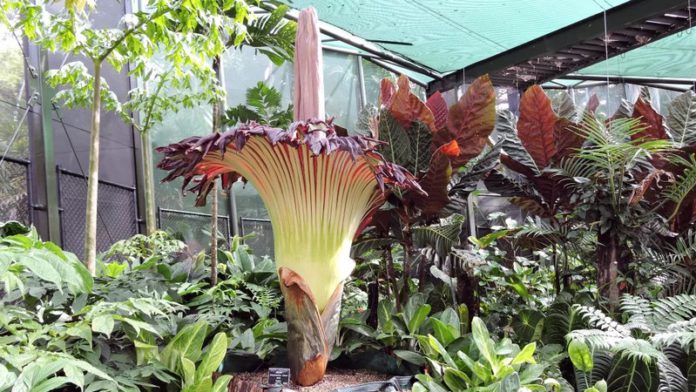The corpse flower (Amorphophallus titanum) also known as titan arum, reeks of rotting flesh and death when in bloom.
Lucky for us, this stinky plant blooms once every seven to nine years according to the Eden Project and each bloom only lasts 24 to 36 hours.
Not only is the corpse flower one of the smelliest plants on Earth, but it also has the largest collection of flowers (inflorescence) in the world. The unpredictable blooming spectacle makes this enigmatic flower a popular visitor attraction at botanic gardens worldwide. The first corpse flower to bloom outside its native Sumatra was at Kew Gardens, UK. in 1889. The putrid-smelling plant has intrigued botanists since it was first scientifically described by Italian botanist Odoardo Beccari in 1878, according to Royal Botanic Garden Edinburgh.
Native to the rainforests of Western Sumatra, Indonesia, the corpse flower is listed as “endangered” on the International Union for Conservations of Nature’s (IUCN) Red List of Threatened Plants. There are fewer than 1,000 individuals thought to be left in the wild according to the United States Botanic Garden.
There is a good reason for the plant’s strong odor. “It all comes down to science,” said Tim Pollak, outdoor floriculturist at the Chicago Botanic Garden. “The smell, color and even temperature of corpse flowers are meant to attract pollinators and help ensure the continuation of the species.”
Pollak explained that dung beetles, flesh flies and other carnivorous insects are the primary pollinators of this type of flower. These insects typically eat dead flesh. The smell and the dark burgundy color of the corpse flower are meant to imitate a dead animal to attract these insects.
Rare blooming of the corpse flower so called because it smells like a rotting corpse pic.twitter.com/4GMl47dSZi
— The Sun (@TheSun) November 2, 2021
“Corpse flowers are also able to warm up to 98 degrees Fahrenheit (36.7 Celsius) to further fool the insects,” Pollak told Live Science. “The insects think the flower may be food, fly inside, realize there is nothing to eat, and fly off with pollen on their legs. This process ensures the ongoing pollination of the species. Once the flower has bloomed and pollination is complete, the flower collapses.”
Pollak wrote on the Chicago Botanic Garden’s blog that analyses show that chemically the stench consists of:
- dimethyl trisulfide (also emitted by cooked onions and limburger cheese)
- dimethyl disulfide (which has an odor like garlic)
- trimethylamine (found in rotting fish or ammonia)
- isovaleric acid (which also causes sweaty socks to stink)
- benzyl alcohol (a sweet floral scent found in jasmine and hyacinth)
- phenol (sweet and medicinal, as in Chloraseptic throat spray)
- indole (like mothballs)
The corpse flower is what is called an inflorescence — a stalk with many flowers, according to the University of California Botanical Garden. A mixture of tiny male and female flowers grow at the base of the spadix, the central phallus-like structure, which is surrounded by the spathe, a pleated skirt-like covering that is bright green on the outside and deep maroon inside when opened. If pollinated, the spadix grows into a large club-like head of orange-red seeds.
The plant itself grows to around 10 to 15 feet (3 to 4.6 meters). The plants typically can grow to a massive 8 feet (2.4 m) tall and the leaves can be as big as 13 feet (4 m) wide. According to the Guinness Book of World Records, the tallest bloom was a corpse flower that measured 10 feet 2.25 inches (3.1 m) tall. It bloomed on June 18, 2010, at Winnipesaukee Orchids in Gilford, New Hampshire.
According to the Eden Project, corpse flowers can take seven to nine years to bloom; some corpse flowers only bloom once every few decades.
Unlike many plants, the corpse flower does not have an annual blooming cycle. The corpse flower only blooms when it has sufficient energy to do so, according to United States Botanic Garden.
The plant’s energy is stored in the corm – a swollen stem base typically weighing around 100 lbs. (45 kilograms). The corpse plant has the world’s largest known corm, sometimes weighing up to 220 lbs. (100kg). During the non-flowering years, a single leaf, the size of a small tree, shoots up from the corm. This leaf branches out into three sections with each of these sprouting more leaflets. Each year, this shooting leaf dies and a new one grows in its place. After many years, the plant finally gathers enough energy to bloom, and once it does, it can only hold the bloom for 24 to 36 hours before it collapses.
Related: Do air purifiers help with bad smells?
Because the flower stays open and emits its odor for just a few days, it can be quite an exciting event for scientists and botany enthusiasts. These bloomings garner media coverage and large crowds of visitors. In July 2016, the New York Botanical Garden extended its summer hours so that guests could catch a glimpse of the blooming flower. In June 2021, a corpse flower bloomed at the United Stated Botanic Garden, visitors watched the event on a live video camera feed posted on the garden’s website.Advertisement
Once the blooming begins, it occurs in two stages on consecutive nights: essentially a “female” stage and a “male” stage. The female flowers form a ring at the bottom of the spadix (inner tube structure), and the male flowers form a ring around the spadix just above the female flowers.
During the first stage, carrion beetles drawn by the stench of death and human-like body temperatures, creep inside the vase-like structure and unknowingly deposit pollen on the receptive female flowers. During the second stage, the structure begins to collapse, the “fragrance” fades and the insects begin to head out. As they leave, the beetles rub up against the pollen in the male flowers and are now ready to carry the pollen to a nearby female flower.

